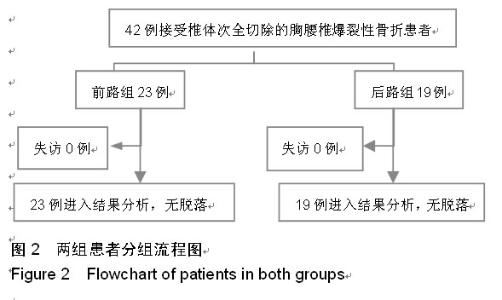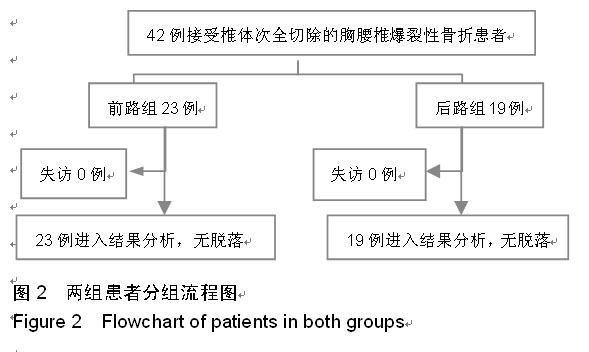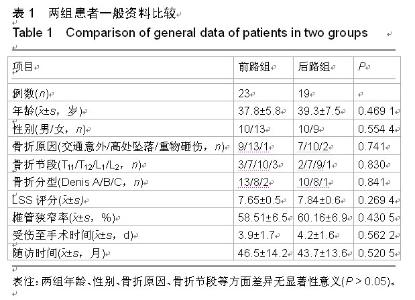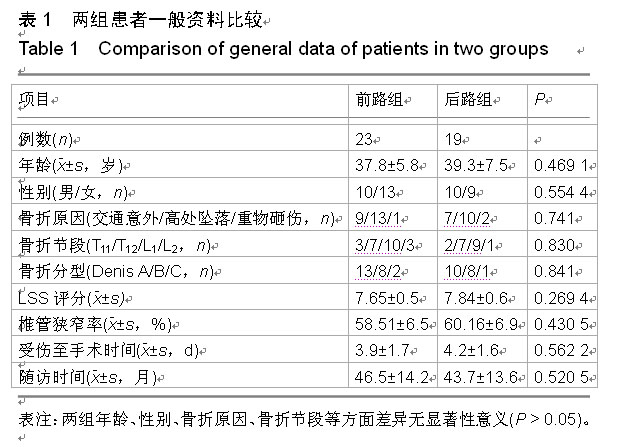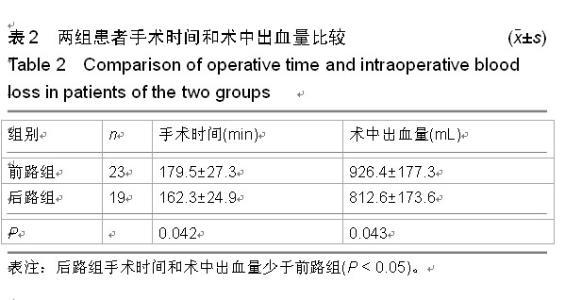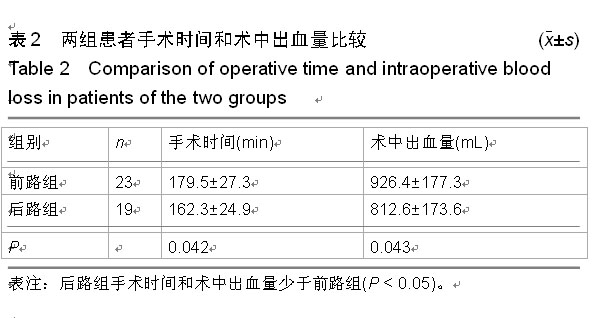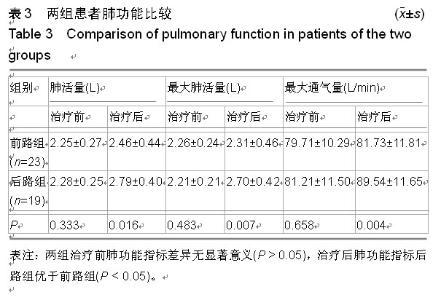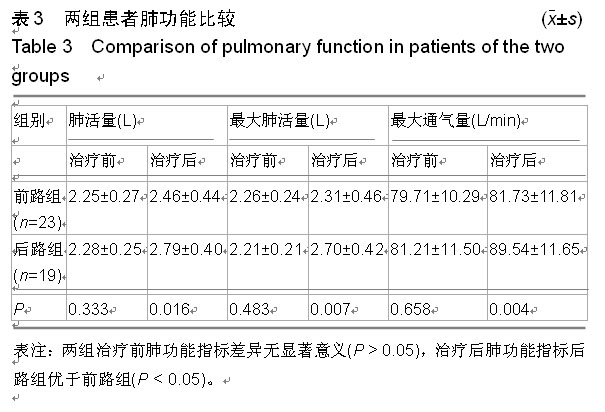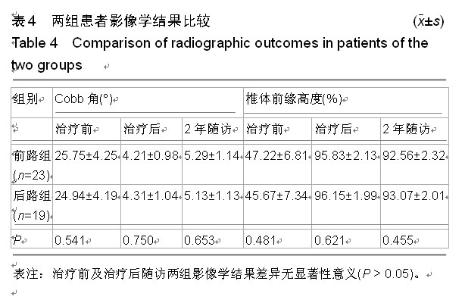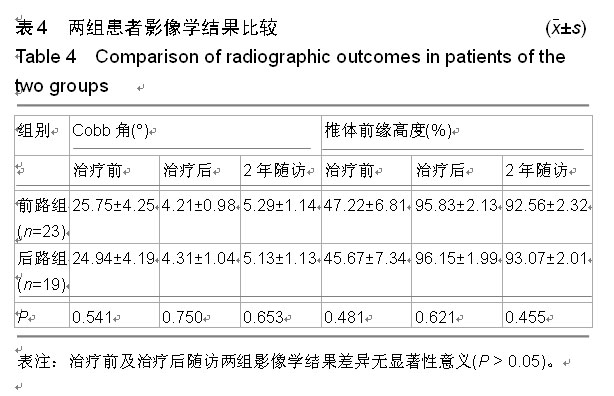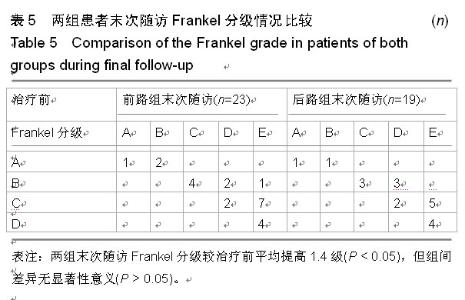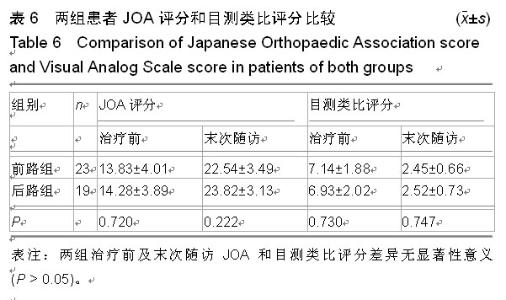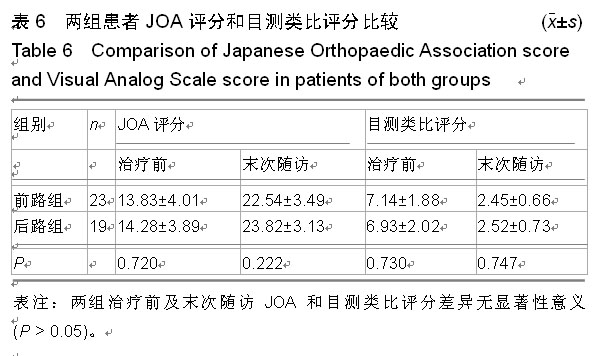Chinese Journal of Tissue Engineering Research ›› 2015, Vol. 19 ›› Issue (22): 3531-3537.doi: 10.3969/j.issn.2095-4344.2015.22.017
Previous Articles Next Articles
Vertebral decompression and implant fixation for thoracolumbar burst fractures: posterior approach is safer in follow-up
Jia Jin-long, Yang Qing-guo, Zhang Yin-shun, Li Wei, Liu Guang-yi
- Department of Spine Surgery, First Affiliated Hospital of Anhui Medical University, Hefei 230022, Anhui Province, China
-
Received:2015-03-20Online:2015-05-28Published:2015-05-28 -
Contact:Yang Qing-guo, Chief physician, Master’s supervisor, Department of Spine Surgery, First Affiliated Hospital of Anhui Medical University, Hefei 230022, Anhui Province, China -
About author:Jia Jin-long, Studying for master’s degree, Department of Spine Surgery, First Affiliated Hospital of Anhui Medical University, Hefei 230022, Anhui Province, China
CLC Number:
Cite this article
Jia Jin-long, Yang Qing-guo, Zhang Yin-shun, Li Wei, Liu Guang-yi. Vertebral decompression and implant fixation for thoracolumbar burst fractures: posterior approach is safer in follow-up [J]. Chinese Journal of Tissue Engineering Research, 2015, 19(22): 3531-3537.
share this article
| [1] Muller U,Berlemann U, Sledge J, et al. Treatment of thoracolumbar burst fractures without neurologic deficit by indirect reduction and posterior instrumentation: bisegmental stabilization with monosegmental fusion.Eur Spine J.1999; 8(4):284-289.
[2] Korovessis P, Baikousis A, Zacharatos S, et al. Combined anterior plus posterior stabilization versus posterior short-segment instrumentation and fusion for mid-lumbar (L2-L4) burst fractures.Spine2006;31(8):859-868.
[3] Schnee CL,Ansell LV. Selection criteria and outcome of operative approaches for thoracolumbar burst fractures with and without neurological deficit.J Neurosurg.1997;86(1): 48-55.
[4] Cresswell TR, Marshall PD, Smith RB. Mechanical stability of the AO internal spinal fixation system compared with that of the hartshill rectangle and sublaminar wiring in the management of unstable burst fractures of the thoracic and lumbar spine.Spine.1998;23(1):111-115.
[5] Gurr KR, McAfee PC, Shih CM. Biomechanical analysis of anterior and posterior instrumentation system after corpectomy: a calf-spine model. J Bone Joint Surg Am. 1988; 70(8):1182-1191.
[6] Parker JW,Lane JR,Karaikovic EE,et al. Successful short-segment instrumentation and fusion for thoracolumbar spine fractures: aconsecutive41 /2-year series.Spine ( Phila Pa 1976 ) .2000;25(9):1157-1170.
[7] Dimar JR II, Wilde PH, Glassman SD, et al. Thoracolumbar burst fractures treated with combined anterior and posterior surgery.Am J Orthop.1996;25(2):159-165.
[8] Danisa OA, Shaffrey CI, Jane JA, et al. Surgical approaches for the correction of unstable thoracolumbar burst fractures: a retrospective analysis of treatment outcomes. J Neurosurg. 1995;83(6):977-983.
[9] 徐华梓,倪文飞,黄其衫,等.后路小切口270°减压重建术治疗严重胸腰椎三柱损失[J].中国脊柱脊髓杂志,2008,18(5):369-372.
[10] 郝永宏,邓树才,马毅,等.经后路椎体次全切除、钛网及椎弓根钉重建术治疗严重胸腰椎骨折[J].中华骨科杂志,2009,29(1):1-6.
[11] Ayberk G, Ozveren MF, Altundal N, et al. Three column stabilization through posterior approach alone: transpedicular placement of distractable cage with transpedicular screw fixation. Neurol Med Chir (Tokyo).2008; 48(1):8-14.
[12] Sasani M, Ozer AF. Single-stage posterior corpectomy and expandable cage placement for treatment of thoracic or lumbar burst fractures. Spine(Phila Pa 1976).2009;34(1): E33-40.
[13] McCormack T, Karaikovic E,Gaines RW. The load sharing classification of spine fractures. Spine ( Phila Pa 1976).1994; 19(15):1741-1744.
[14] Anjarwalla NK, Morcom RK, Fraser RD. Supplementary stabilization with anterior lumbar intervertebral fusion-a radiologic review. Spine(Phila Pa 1976), 2006, 31(11): 1281-1287.
[15] Fukui M, Chiba K, Kawakami M,et al. Japanese Orthopaedic Association Back Pain Evaluation Questionnaire. Part 2. Verification of its reliability : The Subcommittee on Low Back Pain and Cervical Myelopathy Evaluation of the Clinical Outcome Committee of the Japanese Orthopaedic Association. J Orthop Sci. 2007;12(6):526-532.
[16] Huskisson EC. Measurement of pain. Lancet. 1974;2(7889): 1127-1131.
[17] 韦兴,侯树勋,史亚民,等. 661例胸腰椎骨折患者的流行病学分析[J].中国脊柱脊髓杂志,2004,14(7):403-405.
[18] Vaccaro AR,Lim MR,Hurlbert RJ,et al. Surgical decision making unstable thoracolumbar spine injuries: result of a consensus panel review by the spine trauma study group.J Spinal Disord Tech.2006;19(1):1-10.
[19] Alanay A,Acarolu E,Yazici M,et al. Short-segment pedicle instrumentation of thoracolumbar burst fractures:does transpedicular intracorporeal grafting prevent early failure. Spine( Phila Pa 1976).2001;26(2):213-217.
[20] Kaneda K,Taneichi H,Abumi K,et al. Anterior decompression and stabilization with the Kaneda device for thoracolumbar burst fractures associated with neurological deficits. J Bone Joint Surg Am. 1997;79(1):69-83.
[21] Briem D,Lehmann W,Ruecker AH,et al. Factors influencing the quality of life after burst fractures of the thoracolumbar transition. Arch Orthop Trauma Surg.2004;124(7):461-468.
[22] McDonough PW,Davis R,Tribus C,et al.The management of acute thoracolumbar burst fractures with anterior corpectomy and Z-plate fixation.Spine(Phila Pa 1976).2004;29(17): 1901-1908.
[23] Knop C, Fabian HF, Bastian L, et al. Late results of thoracolumbar fractures after posterior instrumentation and transpedicular bone grafting. Spine(Phila Pa 1976).2001; 26(1):88-99.
[24] Verlaan JJ, Diekerhof CH, Buskens E, et al. Surgical treatment of traumatic fractures of the thoracic and lumbar spine: a systematic review of the literature on techniques, complications, and outcome. Spine(Phila Pa 1976). 2004; 29(7):803-814.
[25] Zahra B, Jodoin A, Maurais G, et al. Treatment of thoracolumbar burst fractures by means of anterior fusion and cage. J Spinal Disord Tech.2012;25(1):30-37.
[26] Mariotti AJ,Diwan AD.Current concepts in anterior surgery for thoracolumbar trauma.Orthop Clin North Am.2002;33(2): 403-412.
[27] 欧云生,权正学,蒋电明,等.前路有限减压单节段植骨内固定治疗Denis B型胸腰椎爆裂骨折[J].中华创伤杂志,2008, 24(3): 208-211.
[28] Hitchon PW,Torner J,Eichholz KM,et al.Comparison of anterolateral and posterior approaches in the management of thoracolumbar burst fractures.J Neurosurg Spine.2006;5(2) : 117-125.
[29] Knop C,Lange U,Bastian L,et al.Three-dimensional motion analysis with Synex. Comparative biomechanical test series with a new vertebral body replacement for the thoracolumbar spine.Eur Spine J.2000;9(6):472-485.
[30] Pflugmacher R, Schleicher P, Schaefer J,et al.Biomechanical comparison of expandable cages for vertebral body replacement in the thoracolumbar spine. Spine (Phila Pa 1976). 2004;29(13):1413-1419.
[31] Schreiber U, Bence T, Grupp T,et al. Is a single anterolateral screwplate fixation sufficient for the treatment of spinal fractures in the thoracolumbar junction? A biomechanical in vitro investigation. Eur Spine J.2005;14(2):197-204.
[32] Been HD.Anterior decompression and stabilization of thoracolumbar burst fractures by the use of the Slot-Zielke device.Spine.1991;16(1):70-77.
[33] Brau SA,Delamarter RB,Schiffman ML,et al.Left iliac artery thrombosis during anterior surgery. Ann Vasc Surg.2004; 18(1):48-51.
中国组织工程研究杂志出版内容重点:人工关节;骨植入物;脊柱;骨折;内固定;数字化骨科;组织工程
|
| [1] | Song Chengjie, Chang Hengrui, Shi Mingxin, Meng Xianzhong. Research progress in biomechanical stability of lateral lumbar interbody fusion [J]. Chinese Journal of Tissue Engineering Research, 2021, 25(6): 923-928. |
| [2] | Yang Qin, Zhou Honghai, Chen Longhao, Zhong Zhong, Xu Yigao, Huang Zhaozhi. Research status and development trend of pelvic reconstruction techniques: a bibliometric and visual analysis [J]. Chinese Journal of Tissue Engineering Research, 2021, 25(23): 3718-3724. |
| [3] | Zhao Hongshun, A Jiancuo, Wang Deyuan, Xu Zhihua, Gao Shunhong. Factors affecting the height of early intervertebral space after lumbar interbody fusion via lateral approach [J]. Chinese Journal of Tissue Engineering Research, 2021, 25(21): 3332-3336. |
| [4] | Zhang Chongfeng, Li Xianlin, Peng Weibing, Jia Hongsheng, Cai Lei. Treating lumbar disc herniation of blood stasis type with Chinese herbs, acupuncture, moxibustion, and massage: a Bayesian network Meta-analysis [J]. Chinese Journal of Tissue Engineering Research, 2021, 25(17): 2781-2788. |
| [5] |
Zhang Cong, Zhao Yan, Du Xiaoyu, Du Xinrui, Pang Tingjuan, Fu Yining, Zhang Hao, Zhang Buzhou, Li Xiaohe, Wang Lidong.
Biomechanical analysis of the lumbar spine and pelvis in adolescent
idiopathic scoliosis with lumbar major curve |
| [6] | Fang Yi, Zhao Wenzhi, Pan Deyue, Han Xin, Zhang Lu, He Hongtao, Shi Feng, Tian Tingxiao. Acromioclavicular joint dislocation: how to achieve anatomical reduction, sustained stability and micro-motion [J]. Chinese Journal of Tissue Engineering Research, 2020, 24(5): 796-802. |
| [7] | Tuerhongjiang·Abuduresiti, Meng Xiangyu, Maihemuti·Yakufu, Wang Tiantang, Xieraili·Maimaiti, Dai Jifang, Wang Wei. Biomechanical advantages of percutaneous endoscopic lumbar discectomy for lumbar disc herniation [J]. Chinese Journal of Tissue Engineering Research, 2020, 24(36): 5768-5773. |
| [8] | Wang Jing, Xu Shuai, Liu Haiying. Hidden blood loss during posterior lumbar interbody fusion in lumbar spinal stenosis patients with and without rheumatoid arthritis [J]. Chinese Journal of Tissue Engineering Research, 2020, 24(33): 5307-5314. |
| [9] | Shen Canghai, Feng Yongjian, Song Yancheng, Liu Gang, Liu Zhiwei, Wang Ling, Dai Haiyang. Value of quantitative MRI T2WI parameters in predicting surgical outcome of thoracic ossification of the ligamentum flavum [J]. Chinese Journal of Tissue Engineering Research, 2020, 24(18): 2893-2899. |
| [10] | Fu Jiaxin, Xiao Lianping, Wang Shusen, Li Xiaodong, Han Liqiang, Wang Tonghao. Therapeutic effects of paraspinal approach combined with internal fixation through pedicle of fractured vertebra versus traditional AF screw-rod system for thoracolumbar fractures [J]. Chinese Journal of Tissue Engineering Research, 2019, 23(8): 1177-1181. |
| [11] | Qiu Zhongpeng, Li Ke, Li Gang, Liu Keyu, Du Xinhui, Meng Defeng, Shi Chenhui, Wang Weishan. Different treatments for two-part and three-part proximal humeral fractures by Neer classification: follow-up results analyzed using clinical economics [J]. Chinese Journal of Tissue Engineering Research, 2019, 23(8): 1188-1195. |
| [12] | Ke Wei, Li Ke, Wang Sibo, Du Xinhui, Qiu Zhongpeng, Kang Zhilin, Wang Weishan, Li Gang . Open reduction and plate fixation versus closed reduction and external fixation for distal radius fractures: scores and linear regression analysis [J]. Chinese Journal of Tissue Engineering Research, 2019, 23(8): 1196-1202. |
| [13] |
Wen Yi, Su Feng, Liu Su, Zong Zhiguo, Zhang Xin, Ma Pengpeng, Li Yuexuan, Li Rui, Zhang Zhimin.
Establishment of finite element model of L4-5 and mechanical analysis of degenerative intervertebral discs
|
| [14] | Tian Jie, Ru Jiangying. Preservation of the spinous process ligament complex in expanded decompression of lumbar spinal canal: advantages and disadvantages [J]. Chinese Journal of Tissue Engineering Research, 2019, 23(8): 1228-1234. |
| [15] | Wang Liang, Li Lijun, Zhu Fuliang, Jiang Zhuyan, Wang Shuai, Ni Dongkui . Cortical bone trajectory screw versus pedicle screw fixation after posterior lumbar interbody fusion: a meta-analysis [J]. Chinese Journal of Tissue Engineering Research, 2019, 23(8): 1291-1298. |
| Viewed | ||||||
|
Full text |
|
|||||
|
Abstract |
|
|||||
